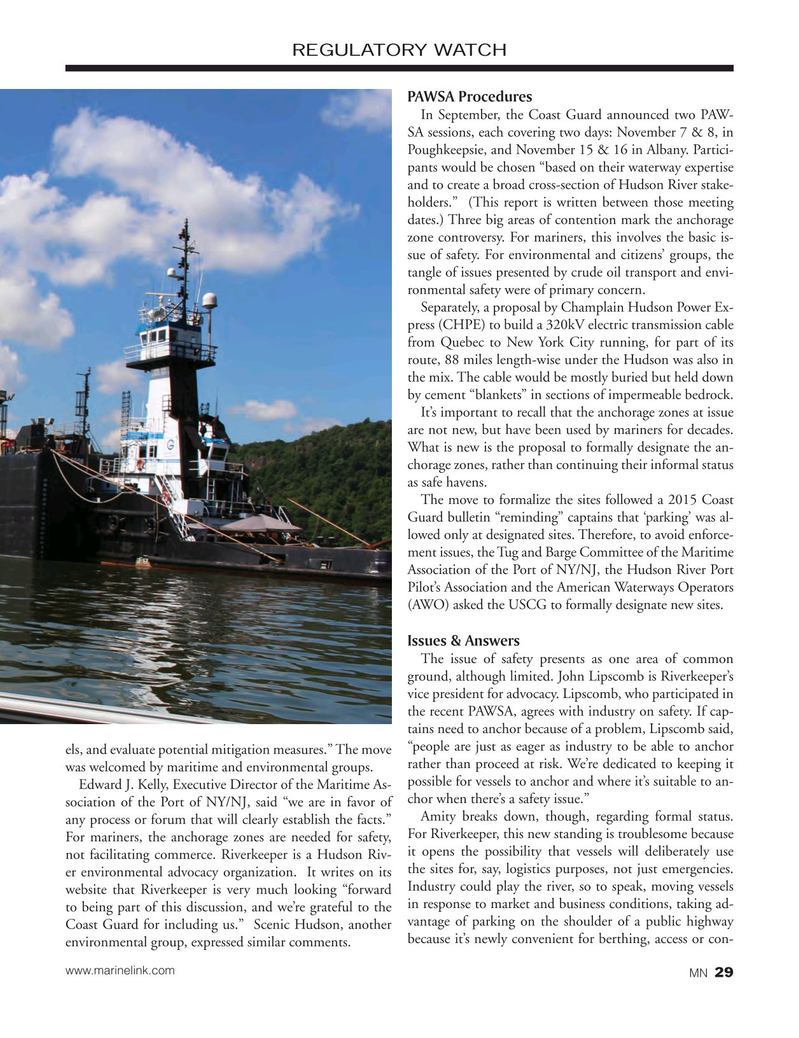
Page 29: of Marine News Magazine (December 2017)
Innovative Products & Boats- 2017
Read this page in Pdf, Flash or Html5 edition of December 2017 Marine News Magazine
REGULATORY WATCH
PAWSA Procedures
In September, the Coast Guard announced two PAW-
SA sessions, each covering two days: November 7 & 8, in
Poughkeepsie, and November 15 & 16 in Albany. Partici- pants would be chosen “based on their waterway expertise and to create a broad cross-section of Hudson River stake- holders.” (This report is written between those meeting dates.) Three big areas of contention mark the anchorage zone controversy. For mariners, this involves the basic is- sue of safety. For environmental and citizens’ groups, the tangle of issues presented by crude oil transport and envi- ronmental safety were of primary concern.
Separately, a proposal by Champlain Hudson Power Ex- press (CHPE) to build a 320kV electric transmission cable from Quebec to New York City running, for part of its route, 88 miles length-wise under the Hudson was also in the mix. The cable would be mostly buried but held down by cement “blankets” in sections of impermeable bedrock.
It’s important to recall that the anchorage zones at issue are not new, but have been used by mariners for decades.
What is new is the proposal to formally designate the an- chorage zones, rather than continuing their informal status as safe havens.
The move to formalize the sites followed a 2015 Coast
Guard bulletin “reminding” captains that ‘parking’ was al- lowed only at designated sites. Therefore, to avoid enforce- ment issues, the Tug and Barge Committee of the Maritime
Association of the Port of NY/NJ, the Hudson River Port
Pilot’s Association and the American Waterways Operators (AWO) asked the USCG to formally designate new sites.
Issues & Answers
The issue of safety presents as one area of common ground, although limited. John Lipscomb is Riverkeeper’s vice president for advocacy. Lipscomb, who participated in the recent PAWSA, agrees with industry on safety. If cap- tains need to anchor because of a problem, Lipscomb said, els, and evaluate potential mitigation measures.” The move “people are just as eager as industry to be able to anchor rather than proceed at risk. We’re dedicated to keeping it was welcomed by maritime and environmental groups.
possible for vessels to anchor and where it’s suitable to an-
Edward J. Kelly, Executive Director of the Maritime As- sociation of the Port of NY/NJ, said “we are in favor of chor when there’s a safety issue.”
Amity breaks down, though, regarding formal status. any process or forum that will clearly establish the facts.”
For mariners, the anchorage zones are needed for safety, For Riverkeeper, this new standing is troublesome because it opens the possibility that vessels will deliberately use not facilitating commerce. Riverkeeper is a Hudson Riv- er environmental advocacy organization. It writes on its the sites for, say, logistics purposes, not just emergencies. website that Riverkeeper is very much looking “forward Industry could play the river, so to speak, moving vessels to being part of this discussion, and we’re grateful to the in response to market and business conditions, taking ad-
Coast Guard for including us.” Scenic Hudson, another vantage of parking on the shoulder of a public highway because it’s newly convenient for berthing, access or con- environmental group, expressed similar comments.
www.marinelink.com 29
MN

 28
28

 30
30
